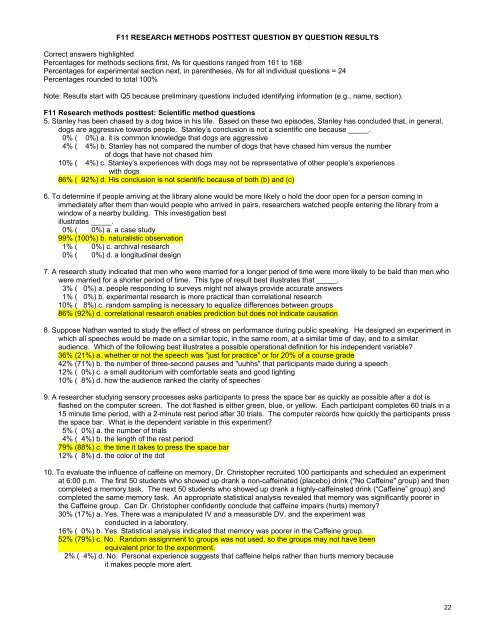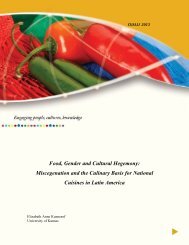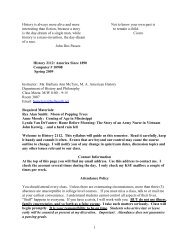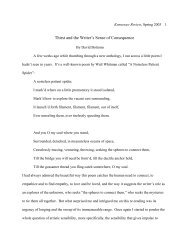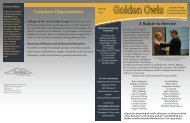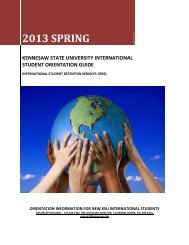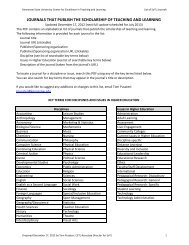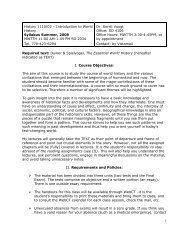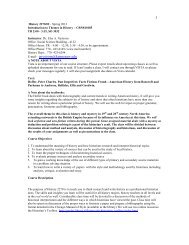2012 Assurance of Learning Report - Kennesaw State University
2012 Assurance of Learning Report - Kennesaw State University
2012 Assurance of Learning Report - Kennesaw State University
Create successful ePaper yourself
Turn your PDF publications into a flip-book with our unique Google optimized e-Paper software.
F11 RESEARCH METHODS POSTTEST QUESTION BY QUESTION RESULTS<br />
Correct answers highlighted<br />
Percentages for methods sections first, Ns for questions ranged from 161 to 168<br />
Percentages for experimental section next, in parentheses, Ns for all individual questions = 24<br />
Percentages rounded to total 100%<br />
Note: Results start with Q5 because preliminary questions included identifying information (e.g., name, section).<br />
F11 Research methods posttest: Scientific method questions<br />
5. Stanley has been chased by a dog twice in his life. Based on these two episodes, Stanley has concluded that, in general,<br />
dogs are aggressive towards people. Stanley’s conclusion is not a scientific one because _____.<br />
0% ( 0%) a. it is common knowledge that dogs are aggressive<br />
4% ( 4%) b. Stanley has not compared the number <strong>of</strong> dogs that have chased him versus the number<br />
<strong>of</strong> dogs that have not chased him<br />
10% ( 4%) c. Stanley’s experiences with dogs may not be representative <strong>of</strong> other people’s experiences<br />
with dogs<br />
86% ( 92%) d. His conclusion is not scientific because <strong>of</strong> both (b) and (c)<br />
6. To determine if people arriving at the library alone would be more likely o hold the door open for a person coming in<br />
immediately after them than would people who arrived in pairs, researchers watched people entering the library from a<br />
window <strong>of</strong> a nearby building. This investigation best<br />
illustrates _____.<br />
0% ( 0%) a. a case study<br />
99% (100%) b. naturalistic observation<br />
1% ( 0%) c. archival research<br />
0% ( 0%) d. a longitudinal design<br />
7. A research study indicated that men who were married for a longer period <strong>of</strong> time were more likely to be bald than men who<br />
were married for a shorter period <strong>of</strong> time. This type <strong>of</strong> result best illustrates that _____.<br />
3% ( 0%) a. people responding to surveys might not always provide accurate answers<br />
1% ( 0%) b. experimental research is more practical than correlational research<br />
10% ( 8%) c. random sampling is necessary to equalize differences between groups<br />
86% (92%) d. correlational research enables prediction but does not indicate causation<br />
8. Suppose Nathan wanted to study the effect <strong>of</strong> stress on performance during public speaking. He designed an experiment in<br />
which all speeches would be made on a similar topic, in the same room, at a similar time <strong>of</strong> day, and to a similar<br />
audience. Which <strong>of</strong> the following best illustrates a possible operational definition for his independent variable?<br />
36% (21%) a. whether or not the speech was "just for practice" or for 20% <strong>of</strong> a course grade<br />
42% (71%) b. the number <strong>of</strong> three-second pauses and "uuhhs" that participants made during a speech<br />
12% ( 0%) c. a small auditorium with comfortable seats and good lighting<br />
10% ( 8%) d. how the audience ranked the clarity <strong>of</strong> speeches<br />
9. A researcher studying sensory processes asks participants to press the space bar as quickly as possible after a dot is<br />
flashed on the computer screen. The dot flashed is either green, blue, or yellow. Each participant completes 60 trials in a<br />
15 minute time period, with a 2-minute rest period after 30 trials. The computer records how quickly the participants press<br />
the space bar. What is the dependent variable in this experiment?<br />
5% ( 0%) a. the number <strong>of</strong> trials<br />
4% ( 4%) b. the length <strong>of</strong> the rest period<br />
79% (88%) c. the time it takes to press the space bar<br />
12% ( 8%) d. the color <strong>of</strong> the dot<br />
10. To evaluate the influence <strong>of</strong> caffeine on memory, Dr. Christopher recruited 100 participants and scheduled an experiment<br />
at 6:00 p.m. The first 50 students who showed up drank a non-caffeinated (placebo) drink ("No Caffeine" group) and then<br />
completed a memory task. The next 50 students who showed up drank a highly-caffeinated drink (“Caffeine” group) and<br />
completed the same memory task. An appropriate statistical analysis revealed that memory was significantly poorer in<br />
the Caffeine group. Can Dr. Christopher confidently conclude that caffeine impairs (hurts) memory?<br />
30% (17%) a. Yes. There was a manipulated IV and a measurable DV, and the experiment was<br />
conducted in a laboratory.<br />
16% ( 0%) b. Yes. Statistical analysis indicated that memory was poorer in the Caffeine group.<br />
52% (79%) c. No. Random assignment to groups was not used, so the groups may not have been<br />
equivalent prior to the experiment.<br />
2% ( 4%) d. No. Personal experience suggests that caffeine helps rather than hurts memory because<br />
it makes people more alert.<br />
22


